Abstract
The high concentration of ascorbate in leucocytes and its rapid expenditure during infection and phagocytosis suggests a role for the vitamin in the immune process. Evidence published to date shows an involvement in the migration and phagocytosis by macrophages and leucocytes, as well as the induction and expression of delayed hypersensitivity. Its effect on antibody production and complement levels is controversial but probably minimal. This study suggests there is room for further investigation into the effect of ascorbate on immunity, particularly with defined populations, but cautions the use of megadose therapy.
Full text
PDF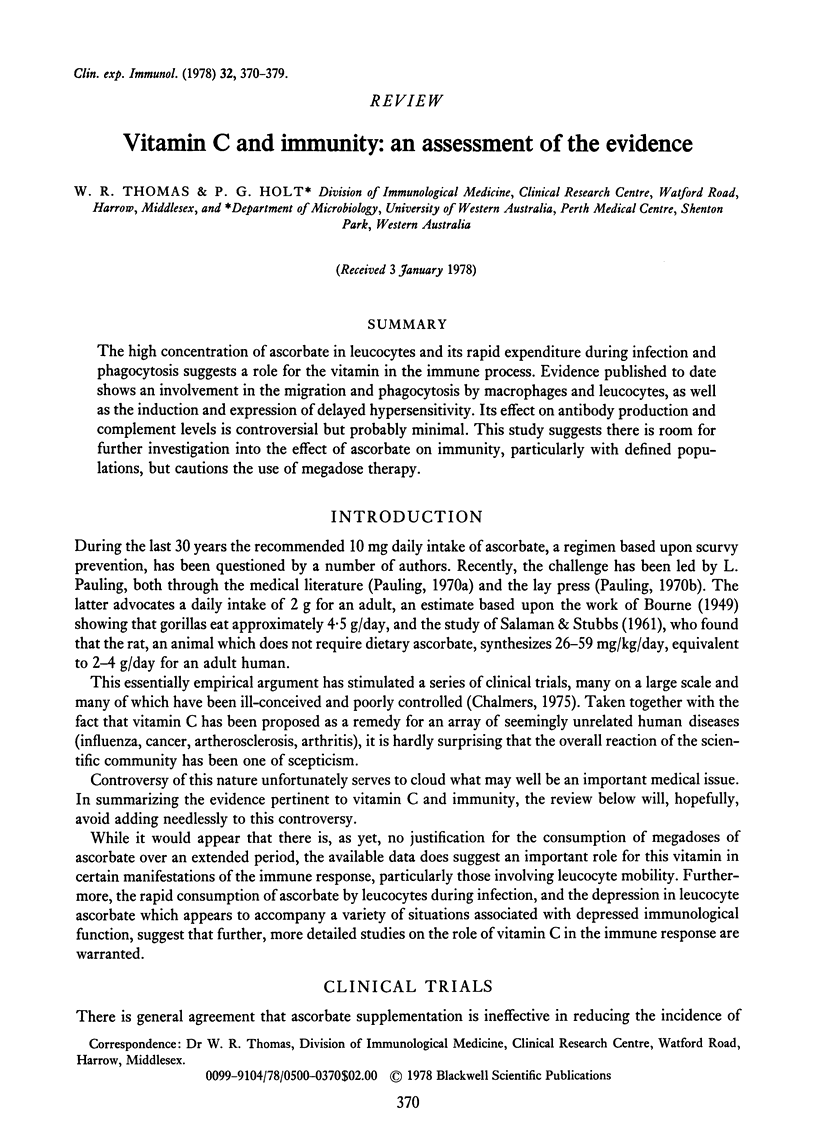
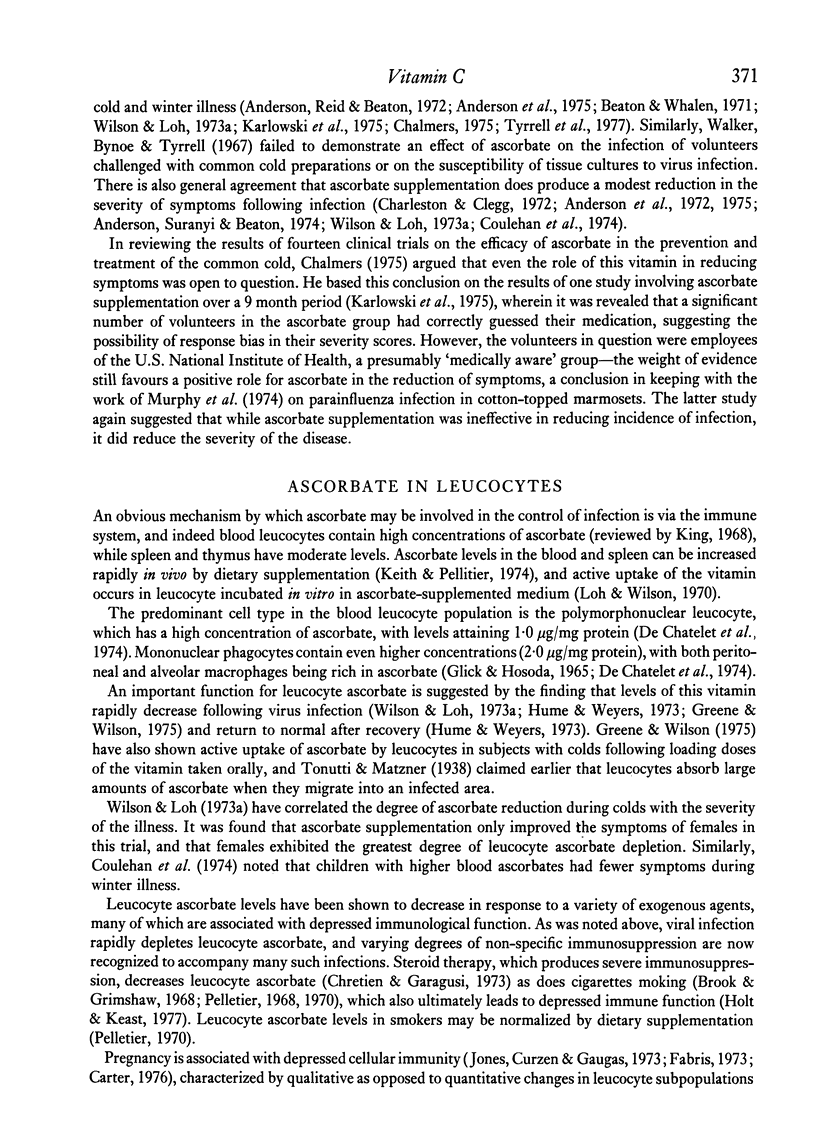
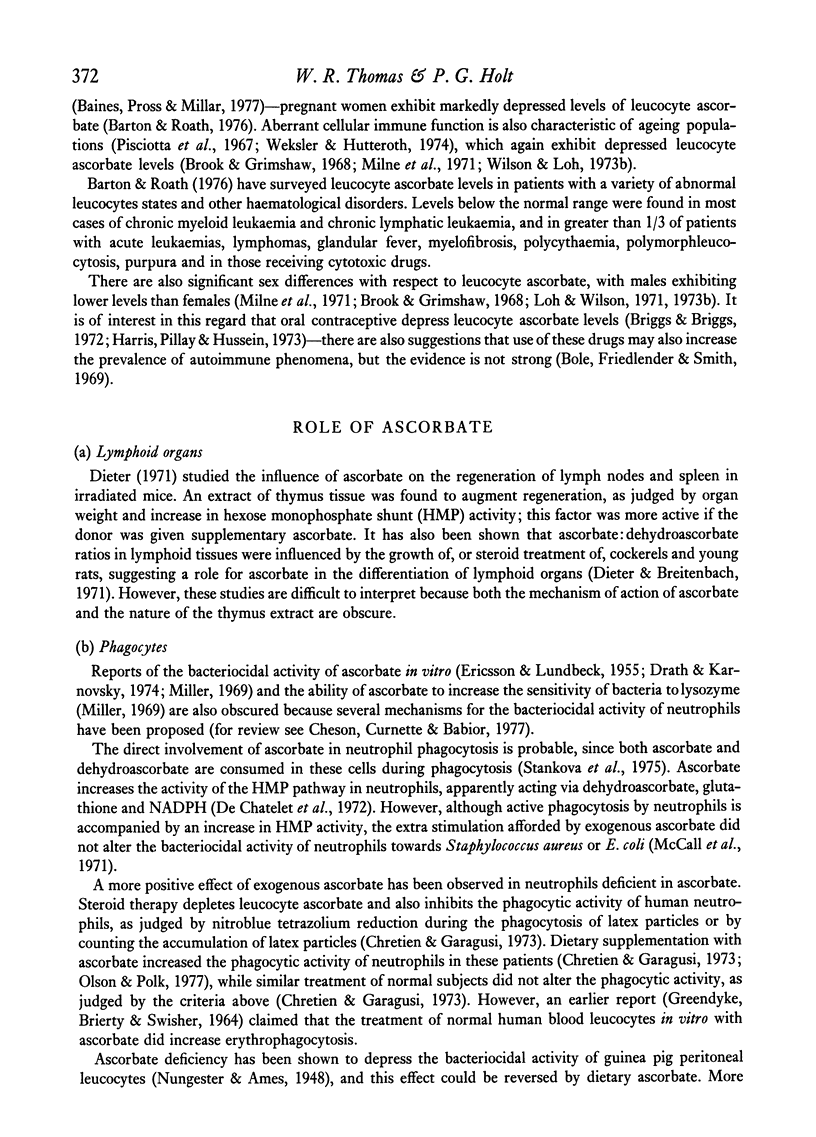
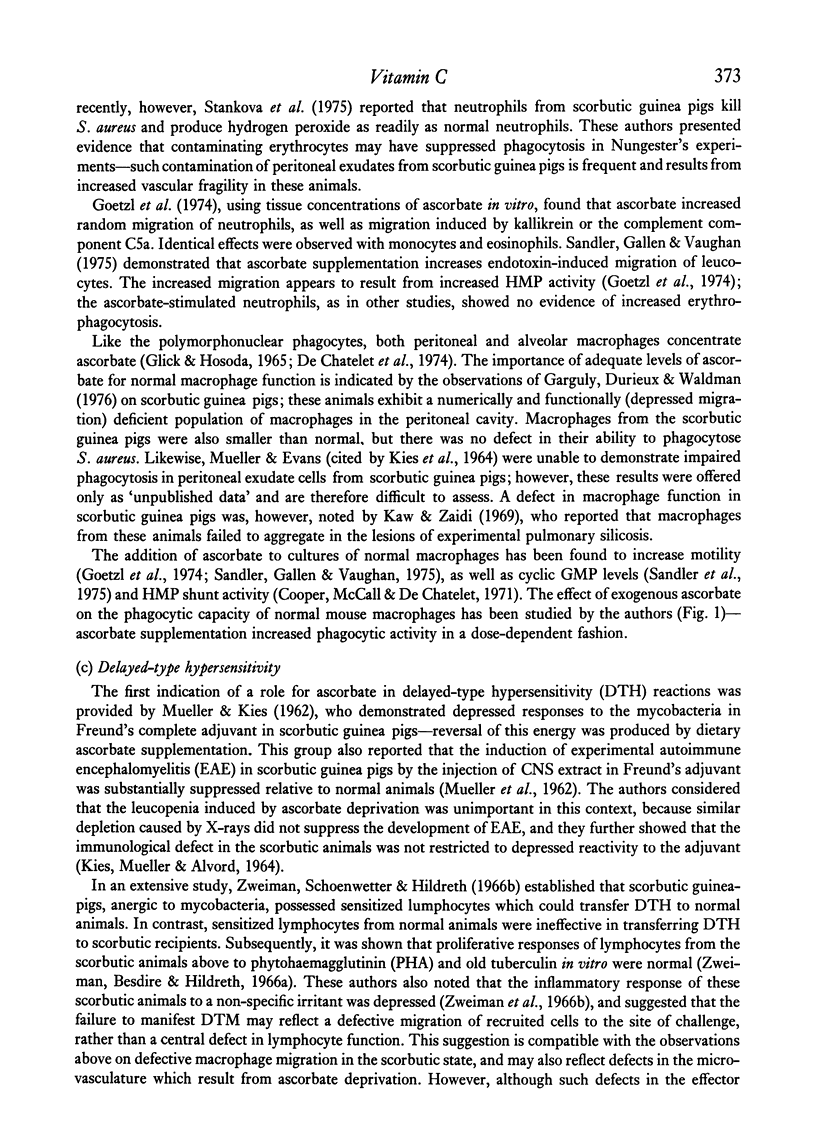

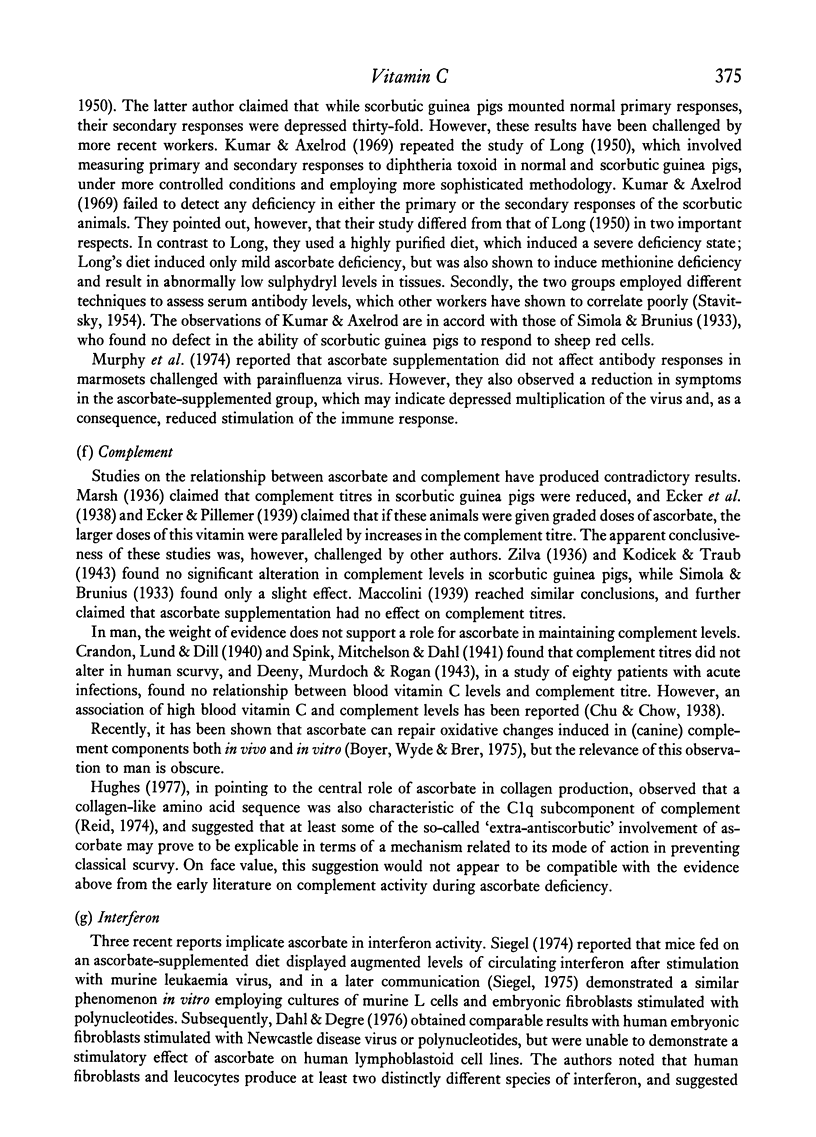

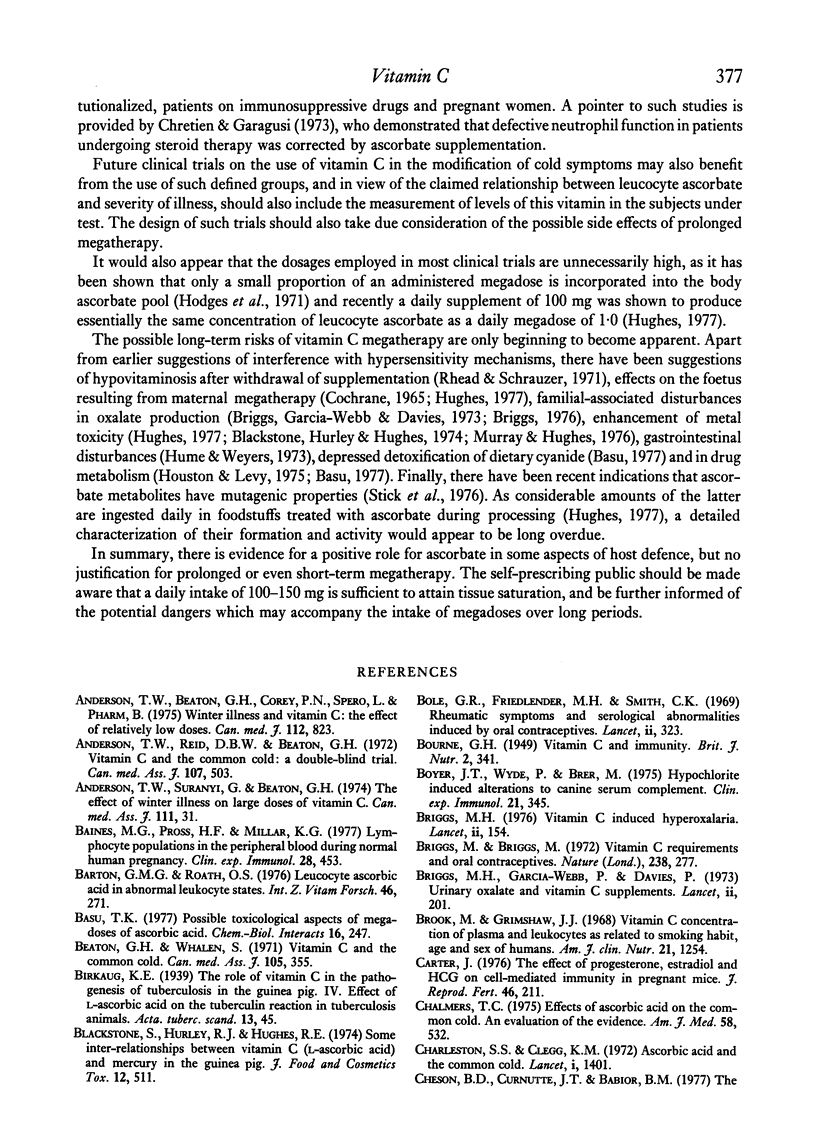
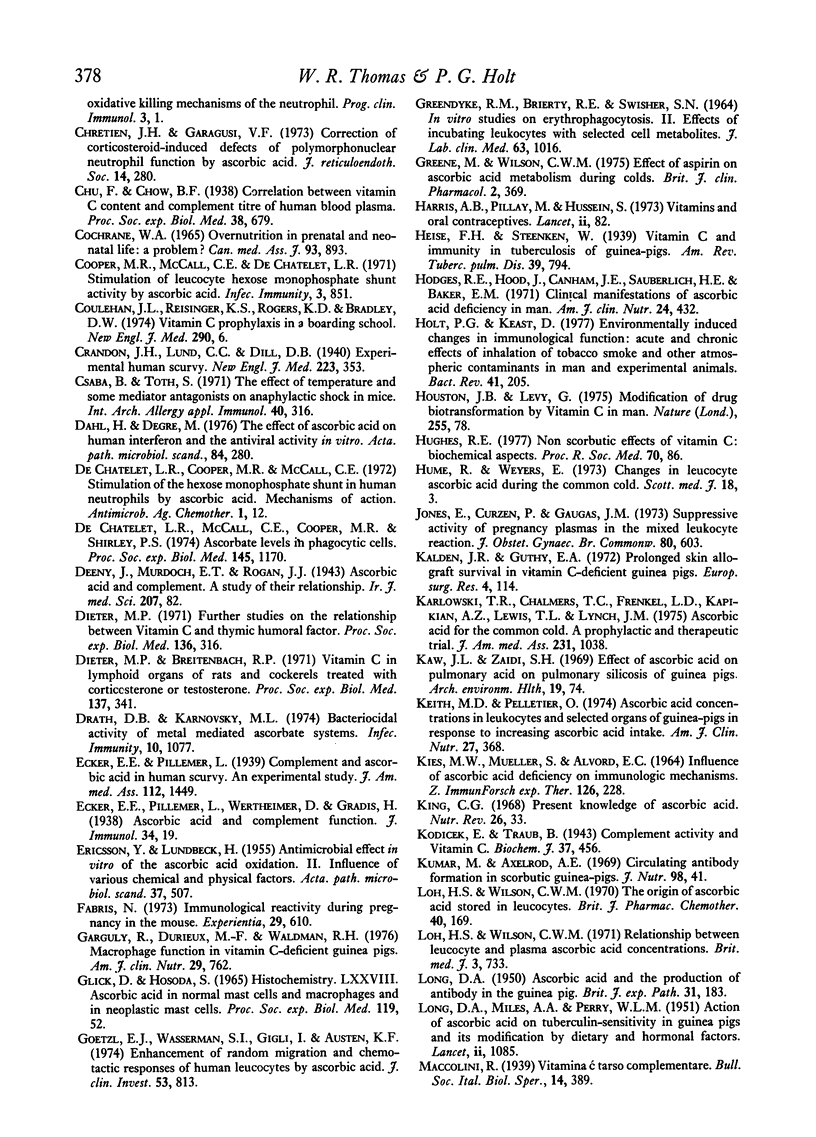

Selected References
These references are in PubMed. This may not be the complete list of references from this article.
- Anderson T. W., Beaton G. H., Corey P., Spero L. Winter illness and vitamin C: the effect of relatively low doses. Can Med Assoc J. 1975 Apr 5;112(7):823–826. [PMC free article] [PubMed] [Google Scholar]
- Anderson T. W., Reid D. B., Beaton G. H. Vitamin C and the common cold: a double-blind trial. Can Med Assoc J. 1972 Sep 23;107(6):503–508. [PMC free article] [PubMed] [Google Scholar]
- Baines M. G., Pross H. F., Millar K. G. Lymphocyte populations in peripheral blood during normal human pregnancy. Clin Exp Immunol. 1977 Jun;28(3):453–457. [PMC free article] [PubMed] [Google Scholar]
- Barton G. M., Roath O. S. Leucocyte ascorbic acid in abnormal leucocyte states. Int J Vitam Nutr Res. 1976;46(3):271–274. [PubMed] [Google Scholar]
- Basu T. K. Possible toxicological aspects of megadoses of ascorbic acid. Chem Biol Interact. 1977 Feb;16(2):247–250. doi: 10.1016/0009-2797(77)90134-x. [DOI] [PubMed] [Google Scholar]
- Blackstone S., Hurley R. J., Hughes R. E. Some inter-relationships between vitamin C (L-ascorbic acid) and mercury in the guinea-pig. Food Cosmet Toxicol. 1974 Aug;12(4):511–516. doi: 10.1016/0015-6264(74)90065-0. [DOI] [PubMed] [Google Scholar]
- Bole G. G., Jr, Friedlaender M. H., Smith C. K. Rheumatic symptoms and serological abnormalities induced by oral contraceptives. Lancet. 1969 Feb 15;1(7590):323–326. doi: 10.1016/s0140-6736(69)91294-x. [DOI] [PubMed] [Google Scholar]
- Boyer J. T., Wyde P., Bier M. Hypochlorite-induced alterations to canine serum complement. Clin Exp Immunol. 1975 Aug;21(2):345–350. [PMC free article] [PubMed] [Google Scholar]
- Briggs M. H., Garcia-Webb P., Davis F. Urinary oxalate and vitamin-C supplements. Lancet. 1973 Jul;2(7822):201–passim. doi: 10.1016/s0140-6736(73)93029-8. [DOI] [PubMed] [Google Scholar]
- Briggs M., Briggs M. Vitamin C requirements and oral contraceptives. Nature. 1972 Aug 4;238(5362):277–277. doi: 10.1038/238277a0. [DOI] [PubMed] [Google Scholar]
- Brook M., Grimshaw J. J. Vitamin C concentration of plasma and leukocytes as related to smoking habit, age, and sex of humans. Am J Clin Nutr. 1968 Nov;21(11):1254–1258. doi: 10.1093/ajcn/21.11.1254. [DOI] [PubMed] [Google Scholar]
- Carter J. The effect of progesterone, oestradiol and HCG on cell-mediated immunity in pregnant mice. J Reprod Fertil. 1976 Jan;46(1):211–216. doi: 10.1530/jrf.0.0460211. [DOI] [PubMed] [Google Scholar]
- Chalmers T. C. Effects of ascorbic acid on the common cold. An evaluation of the evidence. Am J Med. 1975 Apr;58(4):532–536. doi: 10.1016/0002-9343(75)90127-8. [DOI] [PubMed] [Google Scholar]
- Cheson B. D., Curnette J. T., Babior B. M. The oxidative killing mechanisms of the neutrophil. Prog Clin Immunol. 1977;3:1–65. [PubMed] [Google Scholar]
- Chretien J. H., Garagusi V. F. Correction of corticosteroid-induced defects of polymorphonuclear neutrophil function by ascorbic acid. J Reticuloendothel Soc. 1973 Sep;14(3):280–286. [PubMed] [Google Scholar]
- Cochrane W. A. Overnutrition in prenatal and neonatal life: a problem? Can Med Assoc J. 1965 Oct 23;93(17):893–899. [PMC free article] [PubMed] [Google Scholar]
- Cooper M. R., McCall C. E., Dechatelet L. R. Stimulation of leukocyte hexose monophosphate shunt activity by ascorbic Acid. Infect Immun. 1971 Jun;3(6):851–853. doi: 10.1128/iai.3.6.851-853.1971. [DOI] [PMC free article] [PubMed] [Google Scholar]
- Coulehan J. L., Reisinger K. S., Rogers K. D., Bradley D. W. Vitamin C prophylaxis in a boarding school. N Engl J Med. 1974 Jan 3;290(1):6–10. doi: 10.1056/NEJM197401032900102. [DOI] [PubMed] [Google Scholar]
- Csaba B., Tóth S. The effect of temperature and some mediator antagonists on anaphylactic shock in mice. Int Arch Allergy Appl Immunol. 1971;40(2):316–320. doi: 10.1159/000230415. [DOI] [PubMed] [Google Scholar]
- Dahl H., Degré M. The effect of ascorbic acid on production of human interferon and the antiviral activity in vitro. Acta Pathol Microbiol Scand B. 1976 Oct;84B(5):280–284. doi: 10.1111/j.1699-0463.1976.tb01938.x. [DOI] [PubMed] [Google Scholar]
- DeChatelet L. R., Cooper M. R., McCall C. E. Stimulation of the hexose monophosphate shunt in human neutrophils by ascorbic acid: mechanism of action. Antimicrob Agents Chemother. 1972 Jan;1(1):12–16. doi: 10.1128/aac.1.1.12. [DOI] [PMC free article] [PubMed] [Google Scholar]
- DeChatelet L. R., McCall C. E., Cooper M. R., Shirley P. S. Ascorbic acid levels in phagocytic cells. Proc Soc Exp Biol Med. 1974 Apr;145(4):1170–1173. doi: 10.3181/00379727-145-37974. [DOI] [PubMed] [Google Scholar]
- Dieter M. P., Breitenbach R. P. Vitamin C in lymphoid organs of rats and cockerels treated with corticosterone or testosterone. Proc Soc Exp Biol Med. 1971 May;137(1):341–346. doi: 10.3181/00379727-137-35573. [DOI] [PubMed] [Google Scholar]
- Dieter M. P. Further studies on the relationship between vitamin C and thymic humoral factor. Proc Soc Exp Biol Med. 1971 Jan;136(1):316–322. doi: 10.3181/00379727-136-35256. [DOI] [PubMed] [Google Scholar]
- Drath D. B., Karnovsky M. L. Bactericidal activity of metal-mediated peroxide-ascorbate systems. Infect Immun. 1974 Nov;10(5):1077–1083. doi: 10.1128/iai.10.5.1077-1083.1974. [DOI] [PMC free article] [PubMed] [Google Scholar]
- ERICSSON Y., LUNDBECK H. Antimicrobial effect in vitro of the ascorbic acid oxidation. II. Influence of various chemical and physical factors. Acta Pathol Microbiol Scand. 1955;37(6):507–527. doi: 10.1111/j.1699-0463.1955.tb00976.x. [DOI] [PubMed] [Google Scholar]
- Fabris N. Immunological reactivity during pregnancy in the mouse. Experientia. 1973 May 15;29(5):610–612. doi: 10.1007/BF01926697. [DOI] [PubMed] [Google Scholar]
- GLICK D., HOSODA S. HISTOCHEMISTRY 78. ASCORBIC ACID IN NORMAL MAST CELLS AND MACROPHAGES AND IN NEOPLASTIC MAST CELLS. Proc Soc Exp Biol Med. 1965 May;119:52–56. doi: 10.3181/00379727-119-30097. [DOI] [PubMed] [Google Scholar]
- GREENDYKE R. M., BRIERTY R. E., SWISHER S. N. IN VITRO STUDIES ON ERYTHROPHAGOCYTOSIS. II. EFFECTS OF INCUBATING LEUKOCYTES WITH SELECTED CELL METABOLITES. J Lab Clin Med. 1964 Jun;63:1016–1026. [PubMed] [Google Scholar]
- Ganguly R., Durieux M. F., Waldman R. H. Macrophage function in vitamin C-deficient guinea pigs. Am J Clin Nutr. 1976 Jul;29(7):762–765. doi: 10.1093/ajcn/29.7.762. [DOI] [PubMed] [Google Scholar]
- Goetzl E. J., Wasserman S. I., Gigli I., Austen K. F. Enhancement of random migration and chemotactic response of human leukocytes by ascorbic acid. J Clin Invest. 1974 Mar;53(3):813–818. doi: 10.1172/JCI107620. [DOI] [PMC free article] [PubMed] [Google Scholar]
- Hodges R. E., Hood J., Canham J. E., Sauberlich H. E., Baker E. M. Clinical manifestations of ascorbic acid deficiency in man. Am J Clin Nutr. 1971 Apr;24(4):432–443. doi: 10.1093/ajcn/24.4.432. [DOI] [PubMed] [Google Scholar]
- Holt P. G., Keast D. Environmentally induced changes in immunological function: acute and chronic effects of inhalation of tobacco smoke and other atmospheric contaminants in man and experimental animals. Bacteriol Rev. 1977 Mar;41(1):205–216. doi: 10.1128/br.41.1.205-216.1977. [DOI] [PMC free article] [PubMed] [Google Scholar]
- Houston J. B., Levy G. Modification of drug biotransformation by vitamin C in man. Nature. 1975 May 1;255(5503):78–79. doi: 10.1038/255078a0. [DOI] [PubMed] [Google Scholar]
- Hughes R. E. Nonscorbutic effects of vitamin C: biochemical aspects. Proc R Soc Med. 1977 Feb;70(2):86–89. [PMC free article] [PubMed] [Google Scholar]
- Hume R., Weyers E. Changes in leucocyte ascorbic acid during the common cold. Scott Med J. 1973 Jan;18(1):3–7. doi: 10.1177/003693307301800102. [DOI] [PubMed] [Google Scholar]
- Jones E., Curzen P., Gaugas J. M. Suppressive activity of pregnancy plasma on the mixed lymphocyte reaction. J Obstet Gynaecol Br Commonw. 1973 Jul;80(7):603–607. doi: 10.1111/j.1471-0528.1973.tb16033.x. [DOI] [PubMed] [Google Scholar]
- KIES M. W., MUELLER S., ALVORD E. C., Jr INFLUENCE OF ASCORBIC ACID DEFICIENCY ON IMMUNOLOGIC MECHANISMS. Z Immunitats Allergieforsch. 1964 Mar;126:228–233. [PubMed] [Google Scholar]
- Kalden J. R., Guthy E. A. Prolonged skin allograft survival in vitamin C-deficient guinea-pigs. Preliminary communication. Eur Surg Res. 1972;4(2):114–119. doi: 10.1159/000127607. [DOI] [PubMed] [Google Scholar]
- Karlowski T. R., Chalmers T. C., Frenkel L. D., Kapikian A. Z., Lewis T. L., Lynch J. M. Ascorbic acid for the common cold. A prophylactic and therapeutic trial. JAMA. 1975 Mar 10;231(10):1038–1042. [PubMed] [Google Scholar]
- Kaw J. L., Zaidi S. H. Effect of ascorbic acid on pulmonary silicosis of guinea pigs. Arch Environ Health. 1969 Jul;19(1):74–83. doi: 10.1080/00039896.1969.10666807. [DOI] [PubMed] [Google Scholar]
- Keith M. O., Pelletier O. Ascorbic acid concentrations in leukocytes and selected organs of guinea pigs in response to increasing ascorbic acid intake. Am J Clin Nutr. 1974 Apr;27(4):368–372. doi: 10.1093/ajcn/27.4.368. [DOI] [PubMed] [Google Scholar]
- King C. G. Present knowledge of ascorbic acid (vitamin C). Nutr Rev. 1968 Feb;26(2):33–36. doi: 10.1111/j.1753-4887.1968.tb00850.x. [DOI] [PubMed] [Google Scholar]
- Kodicek E. Complement activity and vitamin C. Biochem J. 1943 Oct;37(4):456–460. doi: 10.1042/bj0370456. [DOI] [PMC free article] [PubMed] [Google Scholar]
- Kumar M., Axelrod A. E. Circulating antibody formation in scorbutic guinea pigs. J Nutr. 1969 May;98(1):41–44. doi: 10.1093/jn/98.1.41. [DOI] [PubMed] [Google Scholar]
- LONG D. A., MILES A. A., PERRY W. L. M. Action of ascorbic acid on tuberculin-sensitivity in guinea pigs and its modification by dietary and hormonal factors. Lancet. 1951 May 19;1(6664):1085–1088. doi: 10.1016/s0140-6736(51)92609-8. [DOI] [PubMed] [Google Scholar]
- Loh H. S., Wilson C. W. Relationship between leucocyte and plasma ascorbic acid concentrations. Br Med J. 1971 Sep 25;3(5777):733–735. doi: 10.1136/bmj.3.5777.733. [DOI] [PMC free article] [PubMed] [Google Scholar]
- MUELLER P. S., KIES M. W., ALVORD E. C., Jr, SHAW C. M. Prevention of experimental allergic encephalomyelitis (EAE) by vitamin C deprivation. J Exp Med. 1962 Feb 1;115:329–338. doi: 10.1084/jem.115.2.329. [DOI] [PMC free article] [PubMed] [Google Scholar]
- MUELLER P. S., KIES M. W. Suppression of tuberculin reaction in the scorbutic guinea pig. Nature. 1962 Aug 25;195:813–814. doi: 10.1038/195813a0. [DOI] [PubMed] [Google Scholar]
- Mathews J. D., Whittingham S., Hooper B. M., Mackay I. R., Stenhouse N. S. Association of autoantibodies with smoking, cardiovascular morbidity, and death in the Busselton population. Lancet. 1973 Oct 6;2(7832):754–758. doi: 10.1016/s0140-6736(73)91037-4. [DOI] [PubMed] [Google Scholar]
- McCall C. E., DeChatelet L. R., Cooper M. R., Ashburn P. The effects of ascorbic acid on bactericidal mechanisms of neutrophils. J Infect Dis. 1971 Aug;124(2):194–198. doi: 10.1093/infdis/124.2.194. [DOI] [PubMed] [Google Scholar]
- Miller T. E. Killing and lysis of gram-negative bacteria through the synergistic effect of hydrogen peroxide, ascorbic acid, and lysozyme. J Bacteriol. 1969 Jun;98(3):949–955. doi: 10.1128/jb.98.3.949-955.1969. [DOI] [PMC free article] [PubMed] [Google Scholar]
- Milne J. S., Lonergan M. E., Williamson J., Moore F. M., McMaster R., Percy N. Leucocyte ascorbic acid levels and vitamin C intake in older people. Br Med J. 1971 Nov 13;4(5784):383–386. doi: 10.1136/bmj.4.5784.383. [DOI] [PMC free article] [PubMed] [Google Scholar]
- Murphy B. L., Krushak D. H., Maynard J. E., Bradley D. W. Ascorbic acid (vitamin C) and its effects on parainfluenza type 3 virus infection in cotton-topped marmosets. Lab Anim Sci. 1974 Feb;24(1):229–232. [PubMed] [Google Scholar]
- Murray D. R., Hughes R. E. The influence of dietary ascorbic acid on the concentration of mercury in guinea-pig tissues [proceedings]. Proc Nutr Soc. 1976 Dec;35(3):118A–119A. [PubMed] [Google Scholar]
- Olson G. E., Polk H. C., Jr In vitro effect of ascorbic acid on corticosteroid-caused neutrophil dysfunction. J Surg Res. 1977 Feb;22(2):109–112. doi: 10.1016/0022-4804(77)90048-8. [DOI] [PubMed] [Google Scholar]
- Pauling L. Evolution and the need for ascorbic acid. Proc Natl Acad Sci U S A. 1970 Dec;67(4):1643–1648. doi: 10.1073/pnas.67.4.1643. [DOI] [PMC free article] [PubMed] [Google Scholar]
- Pelletier O. Smoking and vitamin C levels in humans. Am J Clin Nutr. 1968 Nov;21(11):1259–1267. doi: 10.1093/ajcn/21.11.1259. [DOI] [PubMed] [Google Scholar]
- Pelletier O. Vitamin C status of cigarette smokers and nonsmokers. Am J Clin Nutr. 1970 May;23(5):520–524. doi: 10.1093/ajcn/23.5.520. [DOI] [PubMed] [Google Scholar]
- Pisciotta A. V., Westring D. W., DePrey C., Walsh B. Mitogenic effect of phytohaemagglutinin at different ages. Nature. 1967 Jul 8;215(5097):193–194. doi: 10.1038/215193a0. [DOI] [PubMed] [Google Scholar]
- Reid K. B. A collagen-like amino acid sequence in a polypeptide chain of human C1q (a subcomponent of the first component of complement). Biochem J. 1974 Jul;141(1):189–203. doi: 10.1042/bj1410189. [DOI] [PMC free article] [PubMed] [Google Scholar]
- Rhead W. J., Schrauzer G. N. Risks of long-term ascorbic acid overdosage. Nutr Rev. 1971 Nov;29(11):262–263. doi: 10.1111/j.1753-4887.1971.tb03962.x. [DOI] [PubMed] [Google Scholar]
- STAVITSKY A. B. Micromethods for the study of proteins and antibodies. II. Specific applications of hemagglutination and hemagglutination-inhibition reactions with tannic acid and protein-treated red blood cells. J Immunol. 1954 May;72(5):368–375. [PubMed] [Google Scholar]
- Sandler J. A., Gallin J. I., Vaughan M. Effects of serotonin, carbamylcholine, and ascorbic acid on leukocyte cyclic GMP and chemotaxis. J Cell Biol. 1975 Nov;67(2PT1):480–484. doi: 10.1083/jcb.67.2.480. [DOI] [PMC free article] [PubMed] [Google Scholar]
- Siegel B. V. Enhanced interferon response to murine leukemia virus by ascorbic acid. Infect Immun. 1974 Aug;10(2):409–410. doi: 10.1128/iai.10.2.409-410.1974. [DOI] [PMC free article] [PubMed] [Google Scholar]
- Siegel B. V. Enhancement of interferon production by poly(rI)-poly(rC) in mouse cell cultures by ascorbic acid. Nature. 1975 Apr 10;254(5500):531–532. doi: 10.1038/254531a0. [DOI] [PubMed] [Google Scholar]
- Sorensen D. I., Devine M. M., Rivers J. M. Catabolism and tissue levels of ascorbic acid following long-term massive doses in the guinea pig. J Nutr. 1974 Aug;104(8):1041–1048. doi: 10.1093/jn/104.8.1041. [DOI] [PubMed] [Google Scholar]
- Stankova L., Gerhardt N. B., Nagel L., Bigley R. H. Ascorbate and phagocyte function. Infect Immun. 1975 Aug;12(2):252–256. doi: 10.1128/iai.12.2.252-256.1975. [DOI] [PMC free article] [PubMed] [Google Scholar]
- Stich H. F., Karim J., Koropatnick J., Lo L. Mutogenic action of ascorbic acid. Nature. 1976 Apr 22;260(5553):722–724. doi: 10.1038/260722a0. [DOI] [PubMed] [Google Scholar]
- Thomas W. R., Holt P. G., Keast D. Phagocytosis and processing of bacteria by peritoneal macrophages. J Reticuloendothel Soc. 1974 Jan;15(1):16–21. [PubMed] [Google Scholar]
- Tyrrell D. A., Craig J. W., Meada T. W., White T. A trial of ascorbic acid in the treatment of the common cold. Br J Prev Soc Med. 1977 Sep;31(3):189–191. doi: 10.1136/jech.31.3.189. [DOI] [PMC free article] [PubMed] [Google Scholar]
- Walker G. H., Bynoe M. L., Tyrrell D. A. Trial of ascorbic acid in prevention of colds. Br Med J. 1967 Mar 11;1(5540):603–606. doi: 10.1136/bmj.1.5540.603. [DOI] [PMC free article] [PubMed] [Google Scholar]
- Weksler M. E., Hütteroth T. H. Impaired lymphocyte function in aged humans. J Clin Invest. 1974 Jan;53(1):99–104. doi: 10.1172/JCI107565. [DOI] [PMC free article] [PubMed] [Google Scholar]
- Wilson C. W., Loh H. S. Common cold and vitamin C. Lancet. 1973 Mar 24;1(7804):638–641. doi: 10.1016/s0140-6736(73)92202-2. [DOI] [PubMed] [Google Scholar]
- Wilson C. W., Loh H. S. Vitamin C and colds. Lancet. 1973 May 12;1(7811):1058–1059. doi: 10.1016/s0140-6736(73)90692-2. [DOI] [PubMed] [Google Scholar]
- Wilson C. W., Loh H. S., Watters K. Vitamin C metabolism and atopic allergy. Clin Allergy. 1975 Sep;5(3):317–324. doi: 10.1111/j.1365-2222.1975.tb01869.x. [DOI] [PubMed] [Google Scholar]
- Zilva S. S. Vitamin C requirements of the guinea-pig. Biochem J. 1936 Aug;30(8):1419–1429. doi: 10.1042/bj0301419. [DOI] [PMC free article] [PubMed] [Google Scholar]
- Zweiman B., Besdine R. W., Hildreth E. A. The effect of the scorbutic state on tuberculin hypersensitivity in the guinea pig. II. In vitro mitotic response of lymphocytes. J Immunol. 1966 Apr;96(4):672–675. [PubMed] [Google Scholar]
- Zweiman B., Schoenwetter W. F., Hildreth E. A. The effect of the scorbutic state on tuberculin hypersensitivity in the guinea pig. I. Passive transfer of tuberculin hypersensitivity. J Immunol. 1966 Feb;96(2):296–300. [PubMed] [Google Scholar]


